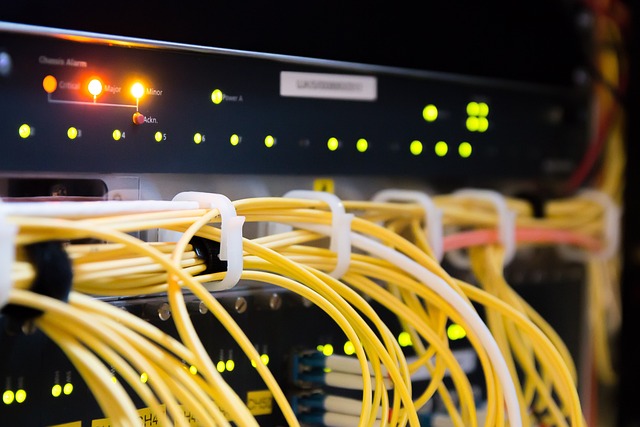Technology
Building a Secure Network Infrastructure for Businesses in 10 Steps
Published
1 year agoon


In today’s digital world, businesses of all sizes are facing an unprecedented threat from cyber-attacks and data breaches. The sensitive nature of the information transmitted and stored on business networks makes it essential for organizations to take proactive steps to protect themselves and their customers. Securing a network infrastructure is critical for any business that wants to safeguard its data and protect itself from potential threats.
In this guide, we will take an in-depth look at the process of secure network installation for businesses. We will explore the essential security measures and best practices, including implementing firewalls, establishing virtual private networks (VPNs), and conducting regular security audits. We will also delve into the latest security technologies and tools, such as intrusion detection and prevention systems. Secure your network security with IT experts at IT Consulting Los Angeles.
By following the ten steps outlined in this guide, businesses can safeguard their networks and protect their valuable data from potential threats.
Assessing Your Current Network Security
Before taking any steps to improve the security of your network, it is essential to understand the current state of your network security. This includes identifying vulnerabilities and potential points of entry for attackers, evaluating the effectiveness of existing security controls, and determining the overall security posture of your network. During this assessment, key areas to focus on include network architecture, software and hardware configurations, and user access controls. Once you have a clear understanding of your network’s current security posture, you can begin to develop a plan for improving it.
Assessing network security is not just limited to your local network but it also means identifying vulnerabilities associated with your company’s data and applications stored across cloud platforms. You need to have multi-cloud security architecture in place if the deployments are across multiple cloud platforms.
Developing a Security Policy
A comprehensive security policy is critical to building a secure network design. It should outline the guidelines and procedures that your organization will use to protect its data and network resources. In addition, the policy should cover topics such as employee training, incident response, and compliance with regulatory requirements. It should also clearly define the roles and responsibilities of different departments and employees and outline the procedures used to monitor and enforce compliance with the policy.
Implementing Firewalls
Firewalls are a critical component of network security, as they help to control incoming and outgoing network traffic. They can block unauthorized access to your network and can also be configured to allow only specific types of traffic through, such as web traffic or email. When selecting a firewall, it’s essential to consider things such as the size of your network, the types of applications that will be used on the web, and the required level of security.
Establishing Virtual Private Networks (VPNs)
VPNs allow employees to securely access the company network remotely, such as at the office or while traveling. It can be useful for employees who work remotely or frequently travel, as it allows them to access company resources and collaborate with colleagues as if they were in the office. When selecting a VPN solution, it’s essential to consider factors such as the number of users connecting remotely, the level of security required, and the types of devices used to connect.
Using Intrusion Detection and Prevention Systems (IDPS)
Intrusion detection and prevention systems (IDPS) monitor network traffic for suspicious activity and can alert administrators to potential security threats. These systems can detect and prevent a wide range of security threats, such as malware, unauthorized access attempts, and denial of service attacks. When selecting an IDPS solution, it’s essential to consider the size of your network, the types of applications that will be used on the web, and the required level of security.
Implementing Access Controls
Access controls are an essential element of network security, as they help to ensure that only authorized users can access sensitive data and network resources. This can include implementing password policies, two-factor authentication, and role-based access controls. When implementing access controls, it’s essential to see the types of users that will be accessing the network, the types of resources that will be protected, and the required level of security.
Conducting Regular Security Audits
Regular security audits are essential for identifying vulnerabilities and ensuring your network is secure. This includes regular vulnerability assessments and penetration testing, which can help to identify potential security issues before attackers can exploit them. When conducting security audits, it’s vital to look at the size of your network infrastructure, the types of applications used on the web, and the required level of network security.
Using Encryption
Encryption is one of the most effective ways to protect sensitive data from being intercepted and viewed by unauthorized parties. Encryption can be applied to different data types, such as email, web traffic, and files stored on laptops and other mobile devices. Some of the most common types of encryption include SSL/TLS for web traffic and full-disk encryption for laptops and mobile devices. Therefore, it’s essential to use robust encryption algorithms and to ensure that encryption keys are properly managed and protected.
Keeping Software Updated
Regularly updating software, including operating systems, applications, and security software can help to protect your network from known vulnerabilities. Software updates often include security patches that address known vulnerabilities and can provide new features and improvements that enhance your network’s security. Establishing a schedule for software updates and ensuring that all devices on your network are updated on time is essential.
Training Employees
Employees are often the weakest link in network security, as they can inadvertently introduce vulnerabilities or fall victim to social engineering attacks. Regular training on security policies and best practices can help to reduce the risk of security incidents caused by human error. Training should cover password management, identifying phishing emails, and safe browsing practices. It’s essential to ensure that all employees know the security policies and procedures in place and understand the importance of following these policies.
Conclusion
Building a secure network infrastructure for businesses is essential in today’s digital age. With the increasing threat of cyber threats and data breaches, businesses must take proactive measures to protect their sensitive information. By following the ten steps outlined in this guide, businesses can safeguard their networks and protect their valuable data from potential threats. It’s important to note that security is an ongoing process. Businesses must continuously monitor and update their network security to keep pace with the ever-evolving cybersecurity threat landscape. By staying vigilant and proactive, companies can protect themselves from potential cyber threats and ensure the safety of their sensitive information.
Post courtesy: Steven Truong, Marketing Coordinator at I.T. Responsive
You may like
-




floLIVE Closes on $47M as Demand for its Unique Hyperlocal Global Network Surges
-




97 Percent of Enterprises in Asia Pacific Using Public Cloud Have Adopted a Multicloud Infrastructure Provider Strategy
-




Huawei Launches Next-Generation ICT Energy Solutions to Drive Low-Carbon Network Development
-




DMaaS Startup Dedoco secures US$3 Million in funding from True Global Ventures
-




Pocket Network Continues to Exceed Web3 Industry Demand with Record Number of Protocol Relays
-




Plume Acquires Network and Security Intelligence Specialist Walleye Networks
Internet of Things
How the Internet of Things Works and How it Benefits Businesses
Published
1 year agoon
January 22, 2023

The Internet of Things (IoT) is a network of interconnected devices that can communicate with one another to exchange data. This network is growing exponentially, and it has the potential to revolutionize many industries. Engage the IT Support Newton team to learn more about IoT.
IoT has a lot of advantages, but why should businesses get involved? In this post, we’ll describe how the Internet of Things works and how it helps businesses. Since IoT is here to stay, we should familiarise ourselves with it.
How Does IoT Work?
One area where the IoT is already having a significant impact on businesses is logistics. For example, IoT devices can be attached to packages as they’re transported, and this information can be used to optimize shipping routes and schedule deliveries. It can also help identify any problems that may occur along the way so that corrective action can be taken quickly.
The IoT is also used in healthcare to track patient health data and generate alerts for abnormalities. This allows doctors to make better decisions based on real-time information rather than waiting for delayed reports from hospitals or clinics.
Security is another area where IoT is used. For example, monitoring the location and condition of security cameras makes it possible to detect any changes or abnormalities in real-time. This allows for quicker response times if there’s an emergency and provides for comprehensive tracking of criminal activity so that justice can be served appropriately.
What are the Benefits of IoT to Organizations?
Minimized Human Labour and Increased Staff Productivity
The internet of things (IoT) is a term used to describe the growing trend of incorporating devices into everyday life to communicate and exchange data. This allows devices to be monitored and managed remotely, which in turn leads to increased staff productivity and reduced human labor.
One of the most common uses for IoT is in the factory environment. By using sensors and actuators embedded in machines, factories can be managed more effectively, and workers can be monitored for safety. This reduces errors and injuries, improves production accuracy, and speeds up the process.
By reducing human labor, IoT solutions have made it possible to use fewer workers to achieve the same results. This has led to increased efficiency and cost savings for companies and greater flexibility and agility.
Effective Management of Operations
The Internet of Things has been heralded as one of the most significant benefits offered by technology. It effectively manages operations by creating a network of devices that can be accessed remotely. This makes it possible to monitor and control equipment and systems in real-time, making it much easier to identify and address problems.
IoT also helps reduce costs associated with inefficient operations. For example, it can automate routine tasks like inventory management so businesses don’t have to waste time and money on mundane tasks that machines could handle more efficiently. In addition, it can help improve safety by monitoring surroundings for potential threats and automatically taking appropriate action.
IoT has proved to be an incredibly effective tool for managing operations. Its ability to streamline processes and communicate information quickly and accurately makes it a valuable asset for businesses of all sizes.
Improved Utilization of Resources and Assets
In the past, businesses have had to spend a lot of time and money managing resources and assets. This is because these resources were often not used to their full potential.
One of the key benefits of IoT is that it allows you to track and monitor all aspects of your resources and assets in real time. This makes it easy to identify problems early on and fix them before they become significant issues. It also allows you to optimize your resources to be used most effectively.
The Internet of Things can also help you better manage your inventory by alerting you when there’s a shortage or surplus of a particular product or resource type. You can then make necessary adjustments in order to meet customer demand without overexerting your resources.
Comprehensive Business Development and Marketing
IoT is a major trend in business development and marketing because it allows enterprises to track everything from customer interactions to sales figures in real time.
This gives businesses an unprecedented level of insight into their customers and their operations. This is especially useful for developing targeted marketing campaigns and improving customer service. Additionally, it can help you better understand your competition and how they’re performing.
Because IoT helps businesses monitor everything from giant factories to small businesses, it has the potential to transform many industries across the board. We may see more widespread use of IoT in marketing and development practices across the board.
Better Business Opportunities
Because IoT solutions are becoming more practical, businesses may now provide a wider choice of services and goods. For example, a company that uses IoT solutions to track inventory can also monitor the warehouse and provide real-time updates on stock levels. This way, customers know exactly what they’re getting, and there’s no need to wait for deliveries or stock to accumulate in warehouses.
Another good business opportunity that comes with using IoT solutions is the ability to measure customer behavior and interactions. This allows businesses to identify how their customers are interacting with their products or services, which can help them make better decisions about future marketing campaigns or product development.
The Bottom Line
As you can see, the Internet of Things (IoT) is recognized as one of the most promising digital technologies. It will undoubtedly grow in popularity and use over the coming years. IoT systems have tremendous capabilities even in their current condition, and their benefits are alluring. It’s crucial to understand, though, that successful IoT integration in an organization takes a lot of work and expertise in order to reap the benefits without experiencing any adverse effects. Therefore, in order to obtain a successful IoT solution, it is most logical to employ the help of trustworthy experts.
Post courtesy: James Richards, CEO at Stronghold Data
Big Data
Top Benefits of Big Data and Analytics for Businesses
Published
1 year agoon
January 20, 2023

In today’s fast-paced business environment, managing and analyzing vast amounts of data is more critical than ever. With the advent of big data and analytics, companies can unlock hidden insights and make data-driven decisions that give them a competitive edge. From improved forecasting and prediction capabilities to enhanced customer experiences, the benefits of data and analytics for businesses are numerous.
In addition, big data and analytics can help companies improve their decision-making capabilities. Businesses can make more informed and accurate decisions by providing real-time access to large amounts of data. This can lead to improved forecasting and prediction capabilities, increased efficiency and productivity, and better resource allocation. Big data and analytics also help companies personalize their products and services, leading to enhanced customer experiences. The team at Managed IT Services Houston helps companies to leverage the power of big data and analytics.
In this blog, we will delve into the top benefits of big data and analytics for businesses and explore how companies can use these technologies to stay ahead of the curve.
Top 6 Benefits of Big Data and Analytics for Businesses
- Unlocking the Power of Decision Making
Big data benefits organizations by making data-driven decisions rather than relying on intuition or guesswork. By leveraging advanced analytics tools, businesses can turn raw data into actionable insights that can inform decisions at all levels of the organization. This leads to more accurate and informed decisions, resulting in improved business outcomes.
Moreover, big data can help organizations identify and mitigate risks by identifying patterns that could indicate a potential problem, such as detecting fraud or identifying a product defect before it becomes a significant issue.
- The Key to Increased Efficiency and Productivity
One of the major benefits of big data is to streamline processes by identifying bottlenecks and inefficiencies. By analyzing data from different parts of the organization, businesses can identify areas where processes can be improved, leading to faster and more efficient operations.
In addition, big data can help organizations to allocate resources better by providing insights into where they are most needed. Businesses can optimize resource allocation by analyzing data on customer demand, production capacity, and other factors, leading to increased efficiency and productivity. So, big data also impacts better forecasting and planning. By analyzing data on past performance, businesses can make more accurate predictions about future demand, allowing them to plan more effectively and avoid costly mistakes.
- Gaining a Competitive Edge
In today’s competitive marketplace, staying competitive is more important than ever. One way to achieve this is by leveraging big data and analytics. By collecting, storing, and analyzing vast amounts of data, organizations can gain insights that were once impossible to uncover. This can give them a significant competitive advantage over their rivals.
Big data and analytics can gain a deep understanding of customers. By analyzing data on customer behavior and preferences, businesses can identify new market opportunities, optimize product offerings, and improve customer engagement. It can increase sales and customer loyalty, giving companies a competitive edge.
- Enhancing Customer Experiences
Providing a superior customer experience is one of the most crucial aspects of business success. And one-way businesses can achieve this is with the power of big data and analytics. Big data and analytics can help organizations identify and anticipate customer needs. By analyzing data on customer interactions, businesses can identify trends and patterns that can help to predict future customer needs. It allows them to proactively adapt their products, services, and customer support, which can lead to improved customer satisfaction.
Additionally, big data and analytics can help organizations to detect and resolve customer complaints quickly. By identifying patterns in customer feedback, businesses can identify common issues and take action to resolve them on time. It can lead to improved customer satisfaction and loyalty.
- Predictive Analytics
Big data and predictive analytics are a powerful combination that can help organizations to unlock the value of big data and make data-driven decisions. Using predictive analytics with big data can identify patterns and trends in data that would be impossible to uncover with smaller data sets.
Predictive analytics can also help organizations to anticipate future trends and identify potential risks and opportunities. By analyzing historical data and identifying patterns, businesses can make more accurate forecasts about future performance. This can inform budgeting, staffing, and other resource allocation decisions, helping organizations to be more proactive and responsive to changes in the market. It also helps to improve business operations and processes. By identifying patterns and trends in data, businesses can identify areas for improvement and take action to optimize their operations.
- A Key Tool for Compliance and Security
Big data and analytics can play a crucial role in ensuring compliance and security for organizations. With the ability to collect and analyze vast amounts of data, these tools can help organizations identify potential risks and vulnerabilities and protect their assets and sensitive information.
Big data analytics benefits organizations in the context of compliance and security is the ability to identify trends and abnormalities in data that may indicate a security threat. By analyzing data from various sources, such as network logs and user activity, businesses can identify potential security risks and take action to mitigate them. In addition, it can help businesses to improve their incident response and disaster recovery capabilities. It also enables companies to anticipate potential threats and plan to respond quickly and effectively.
Conclusion
In a world where data is constantly growing and changing, big data and analytics have become essential tools for businesses to stay competitive and relevant. By harnessing the power of big data and analytics, organizations can gain valuable insights, make data-driven decisions, and optimize their day-to-day operations to drive success. The benefits of big data and analytics extend across various aspects of business, from improving decision-making to gaining a competitive edge and enhancing customer experiences. As the amount of data continues to grow, big data and analytics will play an increasingly vital role in helping businesses navigate the complexities of the digital landscape.
Post courtesy: Scott Young, President at PennComp LLC.
Technology
Top Cloud Migration Challenges and How to Overcome Them
Published
1 year agoon
January 19, 2023

Cloud computing has been one of the most prominent digital transformations in recent years. As a result, the global cloud computing market is expected to reach USD 623 billion by 2023 at a Compound Annual Growth Rate (CAGR) of 18 percent during the forecast period.
Despite the explosive expansion of cloud-based ventures, many organizations are still struggling to take advantage of their full potential due to migration remaining a formidable challenge. In addition, uncertainty about pricing models, data security measures, and internal opposition against change remain obstacles that must be addressed before embarking on this journey. Engage with the cloud migration experts at Managed IT Services Nashville to make a successful cloud migration for your business.
In this blog, you will learn how to overcome the top challenges of cloud migration that most organizations face when transitioning to a cloud environment.
5 Cloud Migration Challenges and How to Overcome Them
- Lack of a Defined Strategy
If you’re planning on cloud migration, it’s essential to have a well-defined strategy and business objectives. Without a plan, you won’t be able to identify challenges and opportunities in the migration process. Unfortunately, this can lead to frustration on both sides, increasing the chance of errors.
Failing to define what data will need to be moved clearly can cause delays and frustration. Not having a clear strategy for security and privacy can also lead to costly mistakes down the road. So it’s vital that you plan everything in detail before starting the migration process.
Ignorance of associated costs can also lead to costly mistakes. For example, if you need to budget for the migration process correctly, it could cost you more money than it would if you had planned it well in advance.
- Security & Privacy
A cloud migration process is a complicated affair, and it requires careful planning. When making the transition to the cloud, you must first assess the level of risk posed by your data and business operations. Then, it will help you choose the right cloud service provider for your business.
After determining the scope of migration, it’s vital to plan for and execute a thorough cloud migration process that considers your organization’s specific needs. It will ensure a successful migration. In addition, to properly secure your data in the cloud, it’s essential to implement robust security measures throughout the entire migration process.
The best way to do this is to monitor and keep track of your cloud migration progress closely to avoid any hiccups in the process.
- Financial cost
The financial cost of a cloud migration can be high, depending on the size and complexity of your system. The timeframe for a cloud migration can also be lengthy, depending on the number and type of data files involved. In addition, several potential risks are involved in cloud migration, such as data loss or downtime. Therefore, to ensure a successful cloud migration, it is essential to have a comprehensive plan in place.
Cloud migration software solution that helps businesses overcome the financial costs associated with cloud migration. The solutions provide insights on data migration, prioritization, and cost-reduction strategies to enable enterprises.
The software identifies and prioritizes data that needs to be moved and helps businesses determine the best way. It also provides guidance on security measures that can be taken during migration and how to reduce the data migration costs best. Overall, the cloud migration software solution helps businesses move data to the cloud at a cost-effective rate and with minimal disruption.
- Cloud Vendor Lock-In
A cloud migration process can be daunting, but with proper planning and execution, it can be successful. Some key challenges you should consider while planning your migration include data security, infrastructure costs, and vendor lock-in.
Identify the key challenges you foresee during the migration process and plan accordingly to ensure a seamless transition to the cloud. Establish a precise schedule and timeline for your project so that deadlines are met without any hitches. Minimize the risk of data loss by following best practices for data preservation and backup.
Use experienced cloud service providers to help ensure a smooth transition to the cloud. A secure cloud environment is vital for business continuity, so it’s essential to plan your migration process well and choose a reliable provider from among the many on offer in today’s market.
- Training Employees on Cloud Solutions
Educating employees is one of the benefits of cloud migration solutions. Educating employees on the benefits of cloud computing can help them understand the benefits of hybrid IT and how it can improve business processes and operations.
Get employees on board with cloud computing by showing them the practical use cases and how it can improve business processes. Provide training on cloud computing to employees through workshops or online training modules. These sessions help employees understand the basics of cloud computing and its various benefits.
Make sure employees are familiar with your migration plan and procedures. It will ensure they know the infrastructure, software, and policies required to migrate to the cloud successfully. In addition, educate employees on how to use your cloud applications securely. Hands-on training is the best way to educate employees on how to use cloud applications securely. This way, employees get an understanding of how to handle sensitive data securely while also learning the dos and don’ts when it comes to using cloud applications. Finally, ensure employees know how to back up and restore data in case of migration failure.
Conclusion
This process of migration to cloud computing involves many challenges. If it’s done wrong, it can be costly, frustrating, and time-consuming. There are also many vital challenges to overcome when migrating to the cloud, including planning for security, data management, and platform migration. To ensure a successful migration, planning and considering all aspects of the migration process is essential. With an organized strategy, migration process, and team support, your organization can successfully transition to cloud-based business systems.
Post courtesy: MCA Technology Solutions, IT Solutions Provider.


A Guide to Help You Find the Best AP Computer Science Tutor


Climate-smart Deeptech Company Ecozen Raises $30 M


BlackSoil’s Investment Grows 40% in FY24; Deploys $118Mn & Clocks 36 New Deals
Saad Kassis Mohamed led WeCare Raises $350000 for Lab-Grown Diamonds
UK-based fintech Nuke From Orbit raises £500k pre-seed funding to deliver smarter smartphone security
Japanese Fintech Leader Smartpay, partners with Chubb Insurance to accelerate digitization of the Japanese Insurance Industry, Anticipated to Surge to 80 Trillion Yen (USD $500 Billion) by 2027
Trending
-



 How to7 years ago
How to7 years agoHow to register a Startup in USA
-
Interview5 years ago
An Interview with Joel Arun Sursas, Head of Clinical Affairs at Biorithm, Singapore
-



 More4 years ago
More4 years ago6 Promising Up and Coming Fashion Companies
-



 More6 years ago
More6 years agoFactors to Consider When Planning Your Office Design and Layout
-



 Interview4 years ago
Interview4 years agoAn Interview with Russell Jack, Southland-based Yogapreneur and Mindfulness Teacher
-



 Other Internet Tech6 years ago
Other Internet Tech6 years agoHow to become an IPTV reseller? A beginner’s guide
-



 More6 years ago
More6 years agoIPTV business for beginners
-



 Business Ideas6 years ago
Business Ideas6 years ago50 Small Business ideas with low investment

